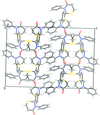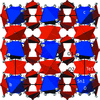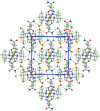issue contents
December 2021 issue

Cover illustration: Bis[hexaaquahemiaquapentakis(μ3-glycinehydroxamato)sulfatopentacopper(II)terbium(III)] sulfate hexahydrate, a new member of the 15-metallacrown-5 family containing copper(II), terbium(III) and glycinehydroxamate dianions has been synthesized and structurally characterized. These mixed lanthanide-transition metal assemblies are of interest for their physical properties (luminescence and the ability to behave as single-moleule magnets) and as building blocks for porous coordination polymers. See: Pavlishchuk, Vasylenko, Zeller & Addison [Acta Cryst. (2021). E77, 1197–1202].
Jerry P. Jasinski tribute
Download citation


Download citation


The structures of 1:1 and 1:2 adducts of phosphanetricarbonitrile with 1,4-diazabicyclo[2.2.2]octane are reported.
Download citation


Download citation


The metallamacrocyclic core of the discrete hexanuclear 15-metallacrown-5 complex [TbCu5(GlyHA)5(H2O)6.5(SO4)]2(SO4)·6H2O contains five copper(II) ions linked by five glycinehydroxamate (GlyHA2–) dianions with a square-antiprismatically octacoordinate terbium(III) ion in the centre. The positive charge of the 15-metallacrown-5 [TbCu5(GlyHA)5]3+ core is compensated by bidentate and non-coordinated sulfate anions.
CCDC reference: 2121203
research communications
Download citation


Download citation


In the crystal, molecules of 4,6-dibromoindolenine are linked by C—Br⋯π halogen bonds, forming zigzag chains propagating in the [001] direction. The molecules of the salt form layers parallel to the (010) plane where they are linked by C—H⋯Br hydrogen bonds C—Br⋯Br and C—Br⋯I halogen bonds.
Download citation


Download citation


The molecular and crystal structures of the title compound, C37H41ClN4O8, which has potential biological activity have been studied. This compound exists in the crystal phase as a methanol solvate.
CCDC reference: 2118094
Download citation


Download citation


Cubic K3MIII(PO3)3N (MIII = Al, Ga) is isostructural with (MIII = Al, V, Ti). In the potassium compounds, the (PO3)3N6– anion coordinates in a tetradentate manner to two potassium cations.
Download citation


Download citation


The ability of 4-[(benzylamino)carbonyl]-1-methylpyridinium to form iodide salts with cation:iodine ratio different from equimolar was studied and a Hirshfeld surface analysis was performed to investigate the intermolecular interactions.
Download citation


Download citation


The AgI atom in the title compound, which exhibits strong blue emission, adopts a highly distorted trigonal–planar geometry coordinated by two pyridine N atoms of two crystallographically independent 2′,6′-difluoro-2,3′-bipyridine ligands and one O atom of the trifluorometanesulfonate anion.
CCDC reference: 2118061
Download citation


Download citation


The structure of (C18H15Sb)3TeO6, contains a [TeO6] octahedral unit linked to three trigonal–bipyramidal [SbC3O2] units via pairs of bridging O atoms to form a discrete molecular unit. The packing of the units is dominated by C—H⋯O hydrogen bonding and weak dispersion forces, with a minor contribution from C—H⋯π bonds and π–π stacking interactions.
CCDC reference: 2118082
Download citation


Download citation


In the title compound, ring conformations in the tetracyclic system are twist, chair, half-chair and boat-chair forms. In the crystal, the intermolecular O—H⋯O hydrogen bonds connect the molecules into a helical chain, and the intermolecular C—H⋯O interactions link the chains into a three-dimensional architecture.
CCDC reference: 2119373
Download citation


Download citation


Caesium lutetium(III) silicate, Cs3LuSi3O9, is a sechser single-chain silicate in which [Si6O18]12− chains are linked together via octahedrally coordinated Lu3+ ions, generating a three-dimensional framework structure. Cs+ ions reside in the voids in the framework.
CCDC reference: 2118472
Download citation


Download citation


Two metal–organic frameworks based on Sr2+ and 1,2,4,5-tetrakis(4-carboxyphenyl)benzene linkers
Two structurally different metal–organic frameworks based on Sr2+ ions and 1,2,4,5-tetrakis(4-carboxyphenyl)benzene linkers have been synthesized solvothermally in different solvent systems, viz. poly[[μ12-4,4′,4′′,4′′′-(benzene-1,2,4,5-tetrayl)tetrabenzoato](dimethylformamide)distrontium(II)], [Sr2(C34H18O8)(C3H7NO)2]n, and poly[tetraaqua[μ2-4,5-bis(4-carboxyphenyl)-4,4′-(benzene-1,2-diyl)dibenzoato]tristrontium(II)], [Sr3(C34H20O8)2(H2O)4]. The differences are noted between the crystal structures and coordination modes of these two MOFs, which are responsible for their semiconductor properties, where structural control over the bandgap is desirable.
Download citation


Download citation


In the first title compound, [Au(C7H11BrN2)2]I, the cations and anions form chains via halogen bond linkages Br⋯I⋯Br. The second title compound, [Au(C7H11BrN2)2][AuI2(C7H11BrN2)2]I2, forms a layer structure involving Br⋯I⋯Br and I⋯I⋯Au linkages.
Download citation


Download citation


The crystal structure of the title compound consists of discrete {[Ni2(κ4-tren)(μ- κ3-tren)]2Ta6O19} cluster molecules that are linked by intermolecular O—H⋯O and N—H⋯O hydrogen bonding into layers extending parallel to the bc plane.
CCDC reference: 2119604
Download citation


Download citation


The first structural examples of complexes with uranium–germanium bonds are presented. The two complexes both have a long U—Ge bond [distances of 3.0428 (7) and 3.0523 (7) Å.
Download citation


Download citation


The synthesis and crystal structure of the racemic title compound C26H24N2O2S2 with two stereocenters is reported.
CCDC reference: 2119921
Download citation


Download citation


2-{[(E)-(3-Cyclobutyl-1H-1,2,4-triazol-5-yl)imino]methyl}phenol was synthesized by an eco-friendly microwave-assisted method that is highly selective and efficient. In the crystal, molecules are linked by N—H⋯N and C—H⋯O hydrogen bonds.
CCDC reference: 2120120
Download citation


Download citation


The copper(II) atom in the molecular title complex has a distorted square-pyramidal coordination environment by three O and two N atoms from a bidentate and a tridentate ligand.
CCDC reference: 2120197
Download citation


Download citation


SnTe3O8 crystallizes isotypically with other members of the series MIVTeIV3O8 (M = Ti, Zr, Hf). It comprises [SnO6] octahedra and [TeO4] bisphenoids as the principal structural building blocks.
CCDC reference: 2120742
Download citation


Download citation


In the crystal, molecules are connected by C—H⋯π and π–π stacking interactions, forming a layer lying parallel to the (11![[\overline{1}]](/e/issues/2021/12/00/is5559/teximages/is5559fi1.svg) ) plane.
) plane.
CCDC reference: 1983650
Download citation


Download citation


The molecular and crystal structures of the chlorobenzene solvate of fluorenonophane have been studied using X-ray diffraction analysis. The fluorenonophane contains two fluorenone fragments linked by two m-substituted benzene fragments. Some decrease in its macrocyclic cavity leads to a stacking interaction between the tricyclic fluorenone fragments. In the crystal, the fluorenonophane and chlorobenzene molecules are linked by weak C—H⋯π(ring) interactions and C—H⋯Cl hydrogen bonds.
CCDC reference: 2121128
Download citation


Download citation


The title compound is a second solvatomorph of the earlier reported compound. The complex nickel(II) anions exhibit an L-shaped geometry. The central Ni atom is in a square-planar N2O2 coordination arrangement. In crystal, the complex nickel(II) anions and the potassium cations form layers stacked along the a-axis direction.
CCDC reference: 2120378
Download citation


Download citation


In the title compound,the two pyridine side arms are not coplanar, with the terminal pyridine rings subtending a dihedral angle of 26.45 (6)°. In the crystal, hydrogen bonds, intermolecular C—H⋯Cl contacts and a weak C—H⋯O interaction connect the molecule with neighbouring chloride counter-anions and lattice water molecules. The crystal packing also features by π–π interactions.
CCDC reference: 2120892
Download citation


Download citation


K1.65Na0.35TiFe(PO4)3 and K0.97Na1.03Ti1.26Fe0.74(PO4)3 are isotypic and crystallize in the langbeinite structure type. K+ and Na+ cations, and Ti3+, Ti4+ and Fe3+ cations, respectively, share the same sites in the crystal structure.
Download citation


Download citation


9-Aminoacridinium chloride N,N-dimethylformamide monosolvate was found to crystallize in the monoclinic space group P21/c. The crystal structure of this compound is stabilized by N—H⋯O and N—H⋯Cl hydrogen bonds, as well as π–π stacking.
CCDC reference: 2120699
Download citation


Download citation


A crystal structure of the anionic tetrakis-complex of lanthanum(III) NMe4LaL4 with the CAPh-ligand dimethyl (2,2,2-trichloroacetyl)phosphoramidate is reported and discussed.
CCDC reference: 2120335
Download citation


Download citation


Single-crystal structure analysis was required to correctly identify the molecular structure and stereochemistry assignment of unexpected impurities in the preparation of a novel pharmaceutical spirocyclic imidazole-amine compound.
Download citation


Download citation


The metal ion of the title salt hydrate shows a 4 + 2 (N4O2) tetragonally elongated coordination geometry defined by four macrocyclic-N atoms and two weakly associated acetate-O atoms; the crystal features conventional hydrogen-bonding interactions.
CCDC reference: 2122547
Download citation


Download citation


The first coordination complex with (5R,6R,7S)-5-(furan-2-yl)-7-phenyl-4,5,6,7-tetrahydro-[1,2,4]triazolo[1,5-α]pyrimidin-6-amino as a bridged ligand coordinating two zinc atoms has been synthesized and studied.
CCDC reference: 2122655
Download citation


Download citation


The unit-cell parameters and interatomic distances of RhPb2 are different from those of the previous studies using powder X-ray diffraction, and Rh is found to be deficient.
CCDC reference: 2123239


 journal menu
journal menu















































